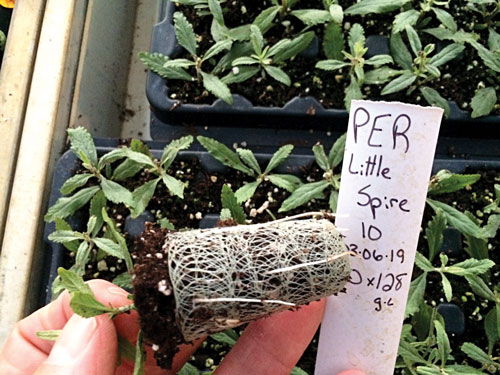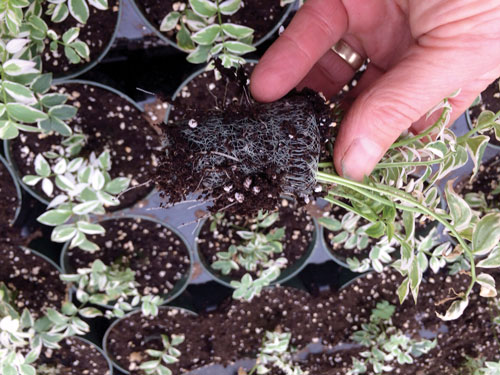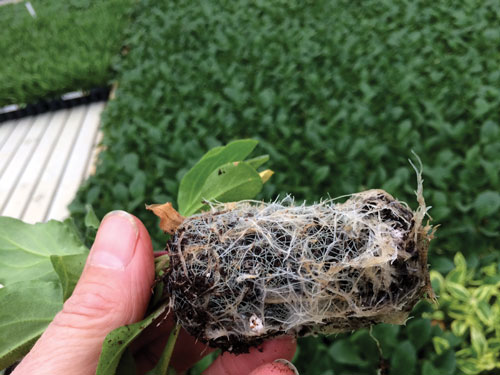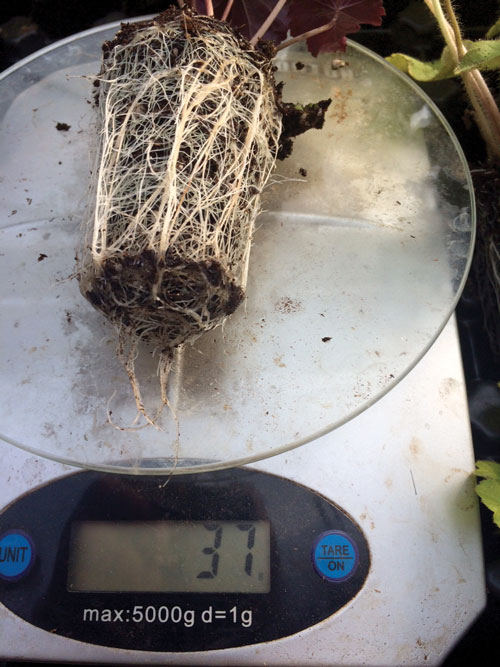7/1/2019
Embracing Change
Roger McGaughey
In order to improve what we’re doing it’s sometimes necessary to change our procedures. Ideally, it’s important to conduct some trials before making changes and thus we can feel confident with the decisions that are made. Sometimes, however, changes are forced on us and we need to view the new situation with a positive attitude and think about how we can improve the status quo.
This spring at Pioneer, we’re involved in some major change. Our greenhouse site has been sold to a marijuana growing company. We’re relocating to a new site, closer to our bareroot growing fields, and building a new facility, which will be more efficient with regards to space utilization. It’ll also be more suited to some new cropping plans that are being projected for future production.
 One change that we’ve already made this winter is to produce all of our perennial plugs in Growcoons. Currently, we grow on large ebb-and-flood tables, which have the advantage of water recycling, but, unfortunately, have created draining and/or drying out issues with the large number of plug trays on each table.
One change that we’ve already made this winter is to produce all of our perennial plugs in Growcoons. Currently, we grow on large ebb-and-flood tables, which have the advantage of water recycling, but, unfortunately, have created draining and/or drying out issues with the large number of plug trays on each table.
Figure 1. The webbed material of Growcoons seem to allow for more all-around cell root growth and roots seem to grow quickly out of the edge of the cell.
Last year at Cultivate, we researched the Growcoon technology and decided to perform some trials to see if that type of rooting container would be better suited to our growing environment. (At that stage, a location move was only in the early discussion stages, so the current relocation changes didn’t have a bearing on our decision-making.)
After a few batches of cuttings had gone through our propagation department, we were beginning to be convinced that we wanted to make a complete change to this rooting system. The webbed material seemed to allow for more all-around cell root growth. Roots seemed to grow quickly out of the edge of the cell, giving us more confidence to move product into a secondary prop environment (Figure 1).
More rapid propagation turnover and a stronger plug seemed like a good result of making a system change. Currently, we’re putting Growcoon cells into the rooting trays by hand, but looking ahead, this process can be mechanized. So, with some investment, more labor savings in the future are possible. Filling these cells with a loose mix provides a good, enclosed, oxygenated rooting environment.
 The thought process here also was this type of cell would be more advantageous for our spring production of field plugs. With our bareroot-grown material, it’s important we have a root system that develops laterally as soon as possible. In previous years, we’ve produced cuttings in a cell filled with a loose mix, but no outer covering. Having recently modified our field planting machine, the Growcoon system seems to be a good fit. Rooted cuttings in a webbed cell should be an easier and faster unit to transplant, potentially resulting in further labor savings. Roots protrude rapidly into the new environment, giving quicker establishment, as can be seen from some greenhouse plantings (Figure 2).
The thought process here also was this type of cell would be more advantageous for our spring production of field plugs. With our bareroot-grown material, it’s important we have a root system that develops laterally as soon as possible. In previous years, we’ve produced cuttings in a cell filled with a loose mix, but no outer covering. Having recently modified our field planting machine, the Growcoon system seems to be a good fit. Rooted cuttings in a webbed cell should be an easier and faster unit to transplant, potentially resulting in further labor savings. Roots protrude rapidly into the new environment, giving quicker establishment, as can be seen from some greenhouse plantings (Figure 2).
Figure 2. It’s easier and faster to root cuttings in a Growcoon, which could potentially result in further labor savings.
Production of a healthy, disease-free root system is of paramount importance. I’ve written often about this subject. RootShield Plus plays a very important part in this process, but what if there was a way to make its effectiveness even better?
Even though we treat all material with liquid RootShield Plus, some of our crops have still had a few disease issues and we’ve had to treat them with chemical fungicides. While keeping up with new available biological products, ON-Gard came to our attention. We’d used this material as a spray additive to help reduce plant stress, but following recommendations from Dr. Matt Krause, Biological Program Manager at BioWorks, Inc., we started adding ON-Gard to the RootShield Plus for our initial
cutting treatment.
 BioWorks’ trials at other growers had shown that the effectiveness of the RSWP Plus was enhanced by the addition of ON-Gard. Obtaining recommendations from a reliable, trustworthy source is always a great thing to have, so this change to procedure seemed like a no-brainer.
BioWorks’ trials at other growers had shown that the effectiveness of the RSWP Plus was enhanced by the addition of ON-Gard. Obtaining recommendations from a reliable, trustworthy source is always a great thing to have, so this change to procedure seemed like a no-brainer.
Following successful in-house trials, we’ve been using this method for most of our current spring season. Obviously, there’s an additional cost to using ON-Gard, but as we’ve so far avoided using any chemical fungicide treatments on our troublesome varieties, we’ve thus saved labor and material costs in those crops. White, healthy roots with lots of root hairs should be very satisfying for our customers (Figure 3).
Figure 3. White, healthy roots with lots of root hairs.
In addition to the changes mentioned above, we’re always trying to make improvements to our watering practices. Using a scale to weigh plugs to help make the “just-right” decision to apply more fertilizer is another change that we’re trying to establish, especially with new trainee water applicators.
Figure 4 shows a heavily rooted plug on a small scale that can be easily carried through the crop. Our experience so far is that the Growcoon plug dries out rapidly, indicating that there continues to be plenty of oxygen exchange within the root zone, which will aid in the development of a strong root structure.
In the final analysis, the success of these production changes will be evident by a quantifiable reduction of shrink in the growing process. Currently, there’s every indication that we’ll achieve this goal, so continued attention to detail will be vital to make sure this becomes a reality.
 As anyone who lives here in the Northeast is aware, the weather this spring has been absolutely terrible. Seemingly never-ending rain and cold temperatures have seriously and adversely affected farming activities. With the delay in field planting so far, it will be even more important that our field plugs get off to a fast start.
As anyone who lives here in the Northeast is aware, the weather this spring has been absolutely terrible. Seemingly never-ending rain and cold temperatures have seriously and adversely affected farming activities. With the delay in field planting so far, it will be even more important that our field plugs get off to a fast start.
The weather conditions have also set back the planting and establishment of our field lobularia banker plants. Some 6-in. pots from a late April trial planting were still alive in early May, but their foliage had turned red and new growth was limited due to the cold temperatures. What adverse effect will the cold conditions eventually have on establishment of our Orius population?
Figure 4. A heavily rooted plug on a small scale.
Here again, keeping abreast of new products is important. We’ve introduced Orius onto our greenhouse-grown young plants, but we already know that the potential population has been inhibited by the cold, wet, dull spring. We’ll introduce Orius into the field crop once it’s developed to an acceptable size, but something to aid its establishment would be a decided advantage.
Biobee is offering a new material called Artemia, a food source that’s been proven on young plant material to increase Orius establishment. When applied to moist foliage, this product seems to provide an attractive food source and aid insect reproduction. A timely application after boom irrigation could be advantageous.
At time of writing in May, we believe that a tape with material attached also may soon be available. Trials have demonstrated that Orius will actually live and reproduce on this tape, so some of this tape will be tested as the season progresses.
Our new greenhouse will undoubtedly present a number of production challenges, but, using our experience and being prepared to adjust as situations demand, we can look forward to successful biological plug production in our new home. GT
Roger McGaughey, head grower at Pioneer Gardens in Deerfield, Massachusetts, was educated in Northern Ireland and England and has 47 years experience as a grower.